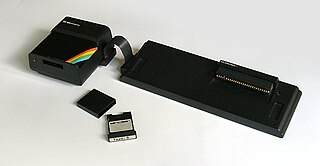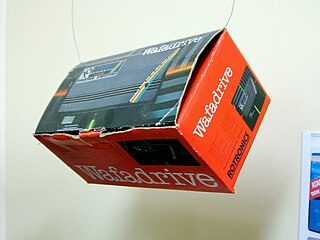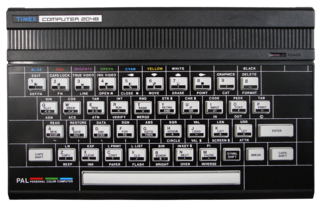The Sinclair QL, is a personal computer launched by Sinclair Research in 1984, as an upper-end counterpart to the Sinclair ZX Spectrum. The QL was aimed at the serious home user and professional and executive users markets from small to large businesses and higher educational establishments, but failed to achieve commercial success.

The ZX Spectrum is an 8-bit personal home computer released in the United Kingdom in 1982 by Sinclair Research.
Ben Cheese was a British engineer who worked on Sinclair's ZX Microdrives. Authors Ian Adamson and Richard Kennedy, in their book Sinclair and the "Sunrise" Technology, write that "it seems only fair to note that it was the tenacity and imagination of R&D staffer Ben Cheese that got the product [i.e., the Microdrive] to the market".
Sinclair BASIC is a dialect of the programming language BASIC used in the 8-bit home computers from Sinclair Research and Timex Sinclair. The Sinclair BASIC interpreter was made by Nine Tiles Networks Ltd.
Miles Gordon Technology, known as MGT, was a small British company, initially specialising in high-quality add-ons for the Sinclair ZX Spectrum home computer. It was founded in June 1986 in Cambridge, England by Alan Miles and Bruce Gordon, former employees of Sinclair Research, after Sinclair sold the rights for the Spectrum to Amstrad. They moved to Swansea, Wales, in May 1989, became a public company in July 1989 and went into receivership in June 1990.

A peripheral from Sinclair Research for its ZX Spectrum home computer, the ZX Interface 1 was launched in 1983. Originally intended as a local area network interface for use in school classrooms, it was revised before launch to also act as the controller for up to eight ZX Microdrive high-speed tape-loop cartridge drives. It also included a DE-9 RS-232 interface capable of operating at up to 19.2 kbit/s — a rare instance of Sinclair using an industry-standard connector. At hardware level it was fundamentally a voltage adaptor, the serial protocol being implemented in software by bit-banging. This led to problems when receiving data, but not when transmitting.

The Exatron Stringy Floppy is a continuous loop tape drive developed by Exatron.
Sinclair Research Ltd is a British consumer electronics company founded by Clive Sinclair in Cambridge. It was originally incorporated in 1973 as Westminster Mail Order Ltd, renamed Sinclair Instrument Ltd, then Science of Cambridge Ltd, then Sinclair Computers Ltd, and finally Sinclair Research Ltd. It remained dormant until 1976, when it was activated with the intention of continuing Sinclair's commercial work from his earlier company Sinclair Radionics, and adopted the name Sinclair Research in 1981.
Timex Sinclair was a joint venture between the British company Sinclair Research and Timex Corporation in an effort to gain an entry into the rapidly growing early-1980s home computer market in North America. The choice of partnership was natural, as Timex was already the main contractor for manufacture of Sinclair's ZX81 and ZX Spectrum computers at its Scottish plant in Dundee. It was Timex of Portugal, though, that took on the R&D and the local manufacturing of the models to be exported to the U.S. Although both Timex of Scotland and Timex of Portugal were full subsidiaries of Timex, internal rivalry, whether unintended or purported, meant there was little sharing between the two plants. Timex of Portugal also sold the Timex Sinclair models in Portugal and Poland under the Timex Computer brand.

The ZX Interface 2 is a peripheral from Sinclair Research for its ZX Spectrum home computer released in September 1983. It has two joystick ports and a ROM cartridge slot, which offers instant loading times. The joystick ports are not compatible with the popular Kempston interface, and thus do not work with most Spectrum games released prior to the launch of the ZX Interface 2. In addition, the pass-through expansion bus provided was stripped, only allowing a ZX Printer to be attached.

The Rotronics Wafadrive was a continuous tape loop storage peripheral launched in late 1984 for the Sinclair ZX Spectrum 8-bit home computer, intended to compete with Sinclair's ZX Interface 1 and ZX Microdrive.
The ZX8302 was a ULA integrated circuit designed for the Sinclair QL microcomputer. Also known as the QL's "Peripheral Chip", it interfaced the CPU to the Microdrives, QLAN local area network interface and RS-232 ports and also provided a real-time clock. The ZX8302 was IC23 on the QL motherboard.

The TC-2048 or Timex Computer 2048 is a 1984 computer created by "Timex North American, Lda", a branch of Timex Corporation.
It was based on the Timex Sinclair 2048 prototype, a 16k version of the TS-2068, with a similar redesign case, Kempston joystick interface and additional video modes.
Despite the fact that the ZX Spectrum hardware was limited by most standards, its software library was very diverse, including programming language implementations, several Z80 assemblers/disassemblers, Sinclair BASIC compilers, Sinclair BASIC extensions, databases, word processors, spread sheets, drawing and painting tools, even 3D modelling (VU-3D), and, of course, many, many games.
Touch Typist Typing Tutor is developed by Sector Software.

Carousel memory is a type of secondary storage for computers, which was created by Swedish computer engineers Erik Stemme and Gunnar Stenudd. It was first shown at an exhibition in Paris in 1958.

Romantic Robot is a small independent British company that publishes classical music recordings. In the 1980s it designed and produced peripherals and software for home computers.









